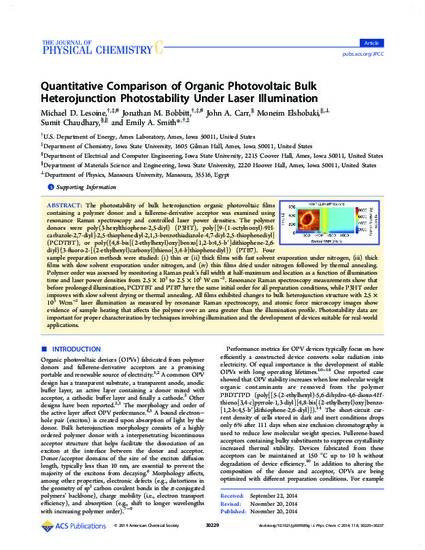
The photostability of bulk heterojunction organic photovoltaic films containing a polymer donor and a fullerene-derivative acceptor was examined using resonance Raman spectroscopy and controlled laser power densities. The polymer donors were poly(3-hexylthiophene-2,5-diyl) (P3HT), poly[[9-(1-octylnonyl)-9Hcarbazole-2,7-diyl]-2,5-thiophenediyl-2,1,3-benzothiadiazole-4,7-diyl-2,5-thiophenediyl] (PCDTBT), or poly({4,8-bis[(2-ethylhexyl)oxy]benzo[1,2-b:4,5-b′]dithiophene-2,6- diyl}{3-fluoro-2-[(2-ethylhexyl)carbonyl]thieno[3,4-b]thiophenediyl}) (PTB7). Four sample preparation methods were studied: (i) thin or (ii) thick films with fast solvent evaporation under nitrogen, (iii) thick films with slow solvent evaporation under nitrogen, and (iv) thin films dried under nitrogen followed by thermal annealing. Polymer order was assessed by monitoring a Raman peak’s full width at half-maximum and location as a function of illumination time and laser power densities from 2.5 × 103 to 2.5 × 105 W cm−2 . Resonance Raman spectroscopy measurements show that before prolonged illumination, PCDTBT and PTB7 have the same initial order for all preparation conditions, while P3HT order improves with slow solvent drying or thermal annealing. All films exhibited changes to bulk heterojunction structure with 2.5 × 105 Wcm−2 laser illumination as measured by resonance Raman spectroscopy, and atomic force microscopy images show evidence of sample heating that affects the polymer over an area greater than the illumination profile. Photostability data are important for proper characterization by techniques involving illumination and the development of devices suitable for real-world applications.
Available at: http://works.bepress.com/emily-smith/18/

Reprinted (adapted) with permission from The Journal of Physical Chemistry C, 118(51); 30229-30237. Doi: 10.1021/jp509589g. Copyright 2014 American Chemical Society.